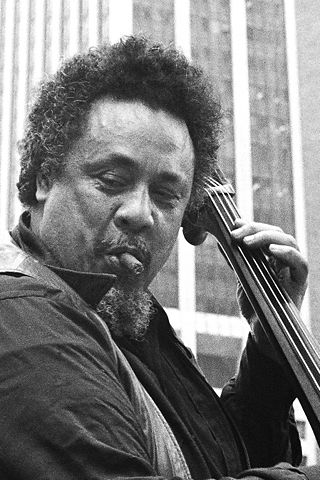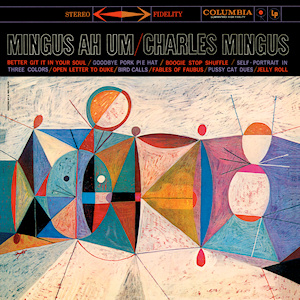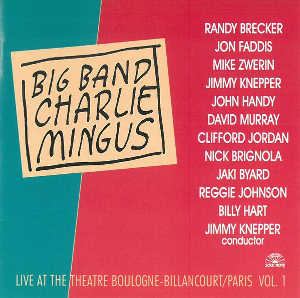
Charles Mingus Jr. was an American jazz upright bassist, composer, bandleader, pianist, and author. A major proponent of collective improvisation, he is considered to be one of the greatest jazz musicians and composers in history, with a career spanning three decades and collaborations with other jazz greats such as Duke Ellington, Charlie Parker, Max Roach, and Eric Dolphy. Mingus's work ranged from advanced bebop and avant-garde jazz with small and midsize ensembles, to pioneering the post-bop style on seminal recordings like Pithecanthropus Erectus (1956) and Mingus Ah Um (1959), and progressive big band experiments such as The Black Saint and the Sinner Lady (1963).

James Minter Knepper was an American jazz trombonist. In addition to his own recordings as leader, Knepper performed and recorded with Charlie Barnet, Woody Herman, Claude Thornhill, Stan Kenton, Benny Goodman, Gil Evans, Thad Jones and Mel Lewis, Toshiko Akiyoshi and Lew Tabackin, and, most famously, Charles Mingus in the late 1950s and early 1960s. Knepper died in 2003 of complications of Parkinson's disease.

John Arthur "Jaki" Byard was an American jazz multi-instrumentalist, composer, and arranger. Mainly a pianist, he also played tenor and alto saxophones, among several other instruments. He was known for his eclectic style, incorporating everything from ragtime and stride to free jazz.

Mingus Mingus Mingus Mingus Mingus is a studio album by the American jazz composer and bassist Charles Mingus which was released on January 9, 1964.

Mingus Ah Um is a studio album by American jazz musician Charles Mingus which was released in October 1959 by Columbia Records. It was his first album recorded for Columbia. The cover features a painting by S. Neil Fujita. The title is a corruption of an imaginary Latin declension. It is common for Latin students to memorize Latin adjectives by first saying the masculine nominative, then the feminine nominative, and finally the neuter nominative singular —implying a transformation of his name, Mingus, Minga, Mingum. The album was inducted into the Grammy Hall of Fame in 2013.

Charles Daniel Richmond was an American jazz drummer who is best known for his work with Charles Mingus. He also worked with Joe Cocker, Elton John and Mark-Almond.

John Richard Handy III is an American jazz musician most commonly associated with the alto saxophone. He also sings and plays the tenor and baritone saxophone, saxello, clarinet, and oboe.

Clifford Laconia Jordan was an American jazz tenor saxophone player. While in Chicago, he performed with Max Roach, Sonny Stitt, and some rhythm and blues groups. He moved to New York City in 1957, after which he recorded three albums for Blue Note. He recorded with Horace Silver, J.J. Johnson, and Kenny Dorham, among others. He was part of the Charles Mingus Sextet, with Eric Dolphy, during its 1964 European tour.

Nicholas Thomas "Nick" Brignola was an American jazz baritone saxophonist.

Mingus Dynasty is a jazz album by Charles Mingus, recorded in 1959 and released on Columbia Records in May 1960. It is a companion album to his 1959 record Mingus Ah Um, and was inducted in the Grammy Hall of Fame in 1999. The title alludes to Mingus's ancestry, which was partially Chinese.
Walter "Baby Sweets" Perkins was an American jazz drummer.

Ricky Ford is an American jazz tenor saxophonist.
Mingus Dynasty was an American jazz ensemble formed in 1979, just after the death of Charles Mingus, which featured many musicians Mingus recorded or played with. The group was named after the 1959 album Mingus Dynasty.

Richard Gene Williams was an American jazz trumpeter.

This Is How I Feel About Jazz is a 1957 album by American musician Quincy Jones, his first full-length album as a bandleader after a recording debut with the 1955 split album Jazz Abroad.

Phantasies is an album by the American jazz pianist Jaki Byard with the Apollo Stompers, recorded in 1984 and released on the Italian Soul Note label.

Phantasies II is an album by the American jazz pianist Jaki Byard with the Apollo Stompers, recorded in 1988 and released on the Italian Soul Note label. The album follows Byard's big band tributes album Phantasies (1984).

Reginald Volney Johnson was an American jazz double-bassist.
Life Is a Many Splendored Gig is an album by the Herb Pomeroy Orchestra.

Live at the Theatre Boulogne-Billancourt/Paris, Vol. 1 is an album by Mingus Dynasty, billed as Big Band Charlie Mingus.

















